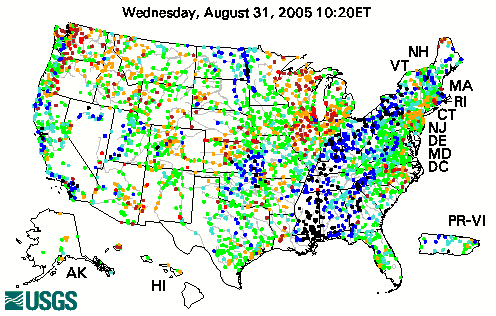
In the southwestern united states they warn you about flash floods in the canyons. Storms dump a few inches of water at someplace upstream and this water is then aggregated into a giant pulse of water that sweeps down thru the canyon your standing in, killing you. The sky is clear and there is very little warning, maybe just a slight increase in the flow before the flood passes thru.
I’ve always been a fan of this realtime stream flow data network the government runs. It allows them to make accurate forecasts for the downstream flooding. The black dots on this chart show the gages pinned to their maxiumum. A number of gages aren’t reporting.
The tree like networks that draw the water out of river basins and down to the sea are made up of billions of links. Each segement of the stream another link. These networks are powerlaw distributed, the mighty rivers at their roots the hubs of thier distribution systems.
On Monday morning I filled the cars with gas, topping them up to capture the last of the gas at last weeks prices. I was actually surprised that none of the gas stations had raised their prices. Gas on the wholesale market in New York was already up and I assumed that station owners would reprice that huge expensive asset each morning. One guy I asked said “Later, we do it around midday.” Another guy said “The boss hasn’t come in yet.”
This morning we were awoken by a sound you don’t hear in the summer. The oil truck was delivering oil across the street. A few minutes ago another oil truck filled the tank of another neighbor. I don’t know if that my neighbor’s topping up, or if it’s their oil guys pushing oil out to their customers so they can, in turn, top up their tanks.
This is an interesting example of the long tail at work. The moment that supply shifts from abundant and dependable to scarce and volitile everybody along the entire distribution system changes their behavior. They address the volitility risk by adding reserves to their storage capacity, but they also shift capital into oil and gas because of the perception that their price will be higher in the future. I.e. it’s a good investment to top up my car’s gas tank or for my neighbors and their oil guy to top up their storage tanks.
This is a facinating example of the long tail at work. If the entire periphery of the distribution system tops up it’s as if the river basin suddenly starts running up hill. The calculations about risk and future values changes for each and every link in the entire distribution chain.